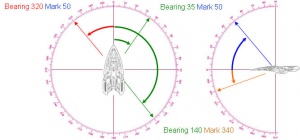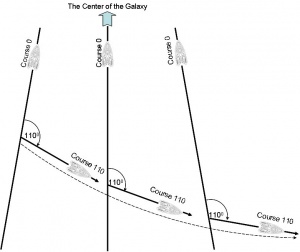Helm and Navigation
Flight operations aboard any space-faring starship are more complicated than within a 2 dimensional space. That is because of the lack of gravity to dictate directions we physically sense. With this, starships pilots are left to interpret flight operations by instrumentation only.
With the lack of gravity there is an absence of a true sense of up and down. As a means of reference it is generally agreed upon by most races that the galactic plane is the horizontal reference (a ‘galactic horizon’) and ‘up’ is perpendicular to the galactic plane in the direction of the north polar field. So while there is no physical limitations imposed of what direction is up, there are indications of such, and are used as a means for navigational reference.
Contents
When dealing with navigation, within a 3 dimensional space, especially within a large area, there are two ways to reference direction. One is relative to yourself, the other is relative to where you want to go.
When dealing with the directional control of a ship, one must understand that there are no limitations, aside from those the inertial dampers and structural integrity will handle. While the ship can handle a full skidding (flat, no bank angle imposed) turn, the standard procedure is to induce a bank angle for all turns; this allows more thrusters to be able to assist in turning the ship.
Relative Bearing
This is direction in reference to your ship. Bearing angles are always relative to the longitudinal axis of the ship, and are a full 360 degrees; this is the same both in turn and pitch. Both pitch and bank begins at 360 (This is commonly ordered as 0 to indicate no directional change). Unless specifically ordered, all directional changes whether to left are right are implied to be at the pilots discretion. In such, a general practice is the turn direction requiring the least amount of correction will be used. For example, all bearing angles 1–180 degrees mean right turns (or pitch up), while angles 181–359 degrees are left turns (or pitch down).
All ordered directions are given in 3 digits, a 90 degree turn to the right would be ordered as 090. The first 3 digits given are always for horizontal changes, turns, where as the second set, separated by a dash in text and verbally stated as ‘mark’ denotes the change in pitch.
Examples: “Turn to a head of 080 mark 179” would mean, unless specified by the ordering officer, a right turn of 80 degrees and a vertical pitch change of 179 degrees.
For orders to ‘inverted’ directions, such as those from the example above, the helm officer will make all effort to keep the ship aligned to the galactic plane by rolling the ship to level. The only exceptions to this are 0 marker 090 and 0 mark 270 where roll has no relevance unless there is a risk of collision.
Course/Heading
“Course” or “Heading” both have the same meaning: The angle between the ship’s track and the straight line to the core of the galaxy. The course is the principal information necessary for the helm officer to a navigate to a distant point. However caution is necessary when using this data. The reason is that since the galaxy is disc shaped, the lines to the core are not parallel but converging. This means that during long trips on a given course the ship’s track will be curved.
Another important issue in setting a course is the random drift caused by the local gravitational fields all along the flight track. The belief that a flight in interstellar space will evolve without any drift is a misconception resulting from the fact that the space – time fabric in interstellar space is almost flat. Following the geometric equivalence, massive space bodies’ gravity fields interact with space – time fabric and finally distort it. The result of this is that the flight path of a starship will be subjected to cross track errors, all along the trip, due to the random drift caused on the space ship following the local distortion of the space – time fabric. Some how like a boat moving in a sea with waves and changing currents. It has to be stressed out however that the course will remain unaffected. In fact as distances in space are enormous, an infinitesimal error or drift of a fraction of degree will result to considerable cross-track errors in tracks and therefore the ship risks never reaching its intended destination point.
According the above explanation, it is not advisable to plan a long trip on a given course but rather to give the destinations sector, star system, or galactic coordinates, and leave the ships flight computer to compensate for the deviations from the initial track, and to plot a direct non-curved course. The manual way of preparing a flight plan is to break the track in many legs with way points, from star to star and for each leg to have a specific course. This last is the recommended way to proceed in unexplored space.
As space is in a 3 dimensional plane, all courses must be given as such. Much like a relative bearing, courses will be given as two sets of three digit numbers separated in writing with a dash and verbally as ‘mark’. As for coordinates, they include the latitude and longitude along with the altitude of the destination.
How Far/Fast?
Space is BIG. A single sector of space is usually about twenty light-years across, which means it can take a while to traverse it. To get an idea of how fast a ship needs to go at a certain speed, we have calculated a Warp Factor table. For the full information about Warp Factors and how they are calculated, see the Warp Factor page.
A copy of the table is below:
Warp Factor Table
| SPEED | KM/H | x LIGHT-SPEED | TO NEAR STAR | ACROSS SECTOR |
| Full Impulse | 270 Million | 0.25 | 20 Years | 80 YEars |
| Warp 1 | 1078 Million | 1 | 5 Years | 20 Years |
| Warp 2 | 11 Billion | 10 | 6 Months | 3 Years |
| Warp 3 | 42 Billion | 39 | 2 Months | 1 Year |
| Warp 4 | 109 Billion | 102 | 18 Days | 2 Months |
| Warp 5 | 230 Billion | 214 | 9 Days | 1 Month |
| Warp 6 | 423 Billion | 392 | 5 Days | 19 Days |
| Warp 7 | 700 Billion | 656 | 3 Days | 11 Days |
| Warp 8 | 1103 Billion | 1,024 | 2 Days | 7 Days |
| Warp 9 | 1.63 Trillion | 1,516 | 1 Day | 5 Days |
| Warp 9.2 | 1.78 Trillion | 1,649 | 1 Day | 4 Days |
| Warp 9.6 | 2.06 Trillion | 1,909 | 23 Hours | 4 Days |
| Warp 9.9 | 3.29 Trillion | 3,053 | 14 Hours | 2 Days |
| Warp 9.99 | 8.53 Trillion | 7,912 | 6 Hours | 22 Hours |
| Warp 9.999 | 215 Trillion | 199,516 | 13 Minutes | 53 Minutes |
| Warp 10 | Infinite | Infinite | 0 | 0 |
- Special thanks to S’Renn Kapetanaki for his contributions on expanding/correcting older tactical information, and for the images.

